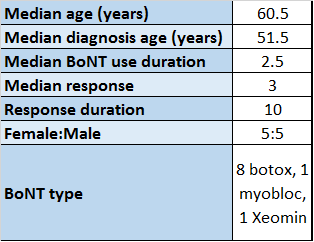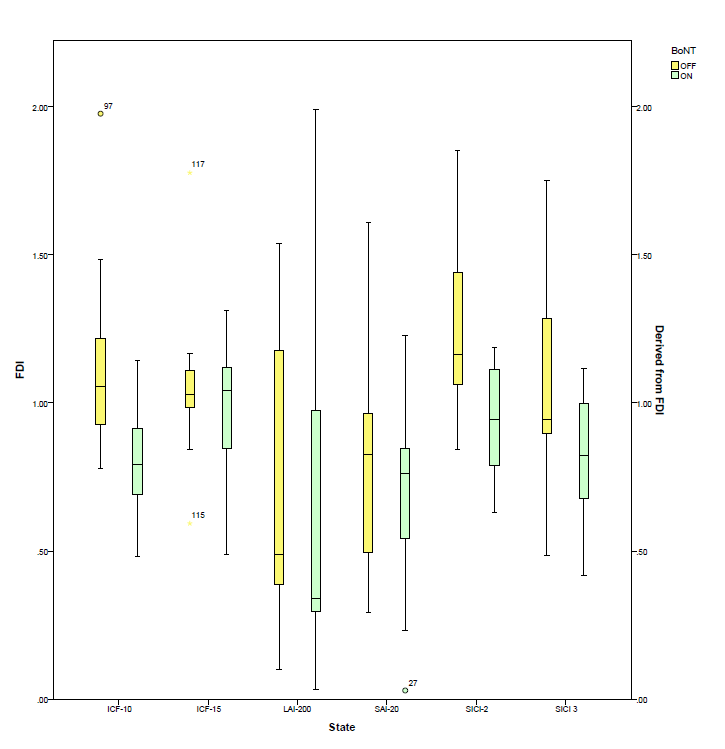Session Information
Date: Sunday, October 7, 2018
Session Title: Dystonia
Session Time: 1:45pm-3:15pm
Location: Hall 3FG
Objective: To examine the physiological effects of botulinum toxin (BoNT) therapy, as measured by paired-pulse transcranial magnetic stimulation (TMS), in patients with primary cervical dystonia (PCD).
Background: BoNT therapy is the gold standard for treatment of PCD. BoNT therapy induces peripheral muscle weakness through inhibition at the neuromuscular junction. However, this is not likely the only mechanism of action with possible central effects. A leading theory underpinning the pathophysiology of dystonia is loss of motor inhibition (or increased excitability) at the level of the spinal cord, brainstem and the motor cortex. TMS is a noninvasive physiological technique for assessment of motor cortex excitability. Paired-pulse TMS paradigms, such as short-interval intracortical inhibition (SICI) and intracortical facilitation (ICF) are well established paradigms for evaluation of motor cortex excitability [Figure 1] as measured by motor evoked potentials (MEP). Similar measures include long-latent afferent inhibition (LAI) and short-latent afferent inhibition (SAI). This study evaluates a possible modulating effect of BoNT on these TMS measures.
Methods: Paired-pulse TMS paradigms (LAI-200, SAI-20, SICI-2, SICI-3, ICF-10, ICF-15) were used two states: 6 weeks after BoNT injection (ON state) and 12 weeks after BoNT injection (relative OFF state). Patients were asked to rate their response to BoNT and the severity of their symptoms recorded using the Toronto Western Spasmodic Torticollis Rating Scale (TWSTRS).
Results: 10 patients with PCD were recruited and finished the protocol. Baseline demographics in [Table 1]. The median response to treatment was reported as very good though there was no statistically significant difference on TWSTRS. An exact Sign test was used to compare the differences in MEP in the ON and OFF states [Table 2]. ICF-10 elicited a higher MEP in the OFF state compared to the ON state (p=0.021). Other TMS paradigms did not achieve a statistically significant difference in MEP between the ON and OFF states despite a possible trend in SICI-2 [Figure 2].
Conclusions: This small study shows a possible modulating effect of BoNT on cortical excitability in patients with PCD as measured using the ICF-10 paired-pulse TMS paradigms. This supports the hypothesis that BoNT has a central modulating effect in addition to a peripheral neuromuscular junction role. A larger study to replicate and confirm this finding is needed.
References: Hallett M. Dystonia: abnormal movements result from loss of inhibition. Adv Neurol 2004;94:1-9. Amadio S, Houdayer E, Bianchi F, et al. Sensory tricks and brain excitability in cervical dystonia: a transcranial magnetic stimulation study. Mov Disord 2014;29:1185-1188.
To cite this abstract in AMA style:
W. Deeb, W. Hu, A. Wagle Shukla. Physiological effects of Botulinum Toxin therapy in Primary Cervical Dystonia [abstract]. Mov Disord. 2018; 33 (suppl 2). https://www.mdsabstracts.org/abstract/physiological-effects-of-botulinum-toxin-therapy-in-primary-cervical-dystonia/. Accessed December 31, 2025.« Back to 2018 International Congress
MDS Abstracts - https://www.mdsabstracts.org/abstract/physiological-effects-of-botulinum-toxin-therapy-in-primary-cervical-dystonia/




